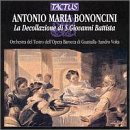| All Artists: Antonio Maria Bononcini, Sandro Volta, Daniela Piccini, Fernanda Piccini, Maurizia Barazzoni, Michel van Goethem, Virgilio Bianconi Title: Bononcini: La Decollazione di S. Giovanni Battista Members Wishing: 1 Total Copies: 0 Label: Tactus Records Release Date: 9/14/1999 Genre: Classical Styles: Opera & Classical Vocal, Historical Periods, Baroque (c.1600-1750) Number of Discs: 1 SwapaCD Credits: 1 UPCs: 723723652225, 8007194101300 |
Search - Antonio Maria Bononcini, Sandro Volta, Daniela Piccini :: Bononcini: La Decollazione di S. Giovanni Battista
 | Antonio Maria Bononcini, Sandro Volta, Daniela Piccini Bononcini: La Decollazione di S. Giovanni Battista Genre: Classical
|
Larger Image |
CD Details |
CD ReviewsNot Giovanni, Boss! His Kid Brother, Tonio! Giordano Bruno | Wherever I am, I am. | 11/18/2008 (5 out of 5 stars) "Lotta good stuff come outa Modena, amici... the best balsamic vinegar, some great pasta recipes, oh yeah, some fabulous tenors... But well before Pavarotti, there was la famiglia Bononcini: padre Giovanni Maria, a noted theorist of music and composer; son Giovanni, a better known composer; and another son, Antonio Maria, whose reputation was then and is now largely absorbed by his older brother's. Many of Antonio's works were falsely attributed to Giovanni even in his lifetime. Judging by this complex and expressive oratorio, The Breakfast of John the Baptist, Antonio may have been the more musically profound of the brothers. (Pardon my sacrilegious humor! Make that "The Decapitation of John the Baptist." It's a matter of one "L".)
Antonio Maria Bononcini (1670-1726) was born in Modena, trained in counterpoint in Bologna, and spent the most productive years of his musical life in the Hapsburg capital Vienna, where he became maestro di cappella. The Viennese court of Joseph I was self-consciously Italianate, using Italian as the language of daily life and cultivating a thoroughly Italian musical establishment. Thus the 'sacred cantata' and the Italian oratorio genres developed in the Papal States found a separate niche in which to evolve. This grand and inventive oratorio by the younger Bononcini is one of the finest results of that evolution. The story of John the Baptist and Salome has to be one of the most intensely emotional of all Biblical tales, as demonstrated in modern times by Richard Strauss. Bononcini's oratorio focuses less on Salome than on John and John's relationship to God, expressed through recitativo dialogue with an Angel. The most moving and original music in the oratorio are the Baptist's arias, sung powerfully on this CD by male alto Micael Van Goethem, whose voice is reminiscent of Gerard Lesne. Soprano Daniela Piccini also sings with affective clarity in the role of Salome. Their voices, one warm and one icy cold, make a dramatically potent combination. Bononcini's orchestral writing is full of surprises, all of them expressively supportive of the arias that they accompany or introduce. The integration of instrumental obbligatos with basso continuo is masterfully fluid. There are relatively few extended passages of recitativo seco in this composition; most of the drama is conveyed in arias and ariosos. Bononcini treats his instrumental ouvertures in elegantly severe simplicity, in keeping with the somber emotions of the singers. This is a very carefully integrated compostion both musically and dramatically. The two choruses, one at mid-point and one as a finale, are not only fine theatrical statements but also very artful contrapuntal compositions. Little Tony knew his craft! The Orchestra dell'Opera Barocca di Guastalla? Not a single name on the roster of string players is familiar to me, though I'm not entirely an outsider to the burgeoning world of Baroque performance in Italy. Nonetheless, they perform this complex masterpiece of orchestral inventiveness with complete aplomb and style. I'll be watching for further reordings from them. My only criticism of this CD would be the sloppiness of the notes: lots of mistranslations and misprints, including in the text of the oratorio. That text, by the way, is only in Italian, and good luck to you even if you speak the lingo! The story, however, is so familiar, and the affect of each aria so clear, that I don't think the absence of an English text will diminish your appreciation significantly. This is definitely a "discovery" performance, which I recommend very highly." |

 Track Listings (26) - Disc #1
Track Listings (26) - Disc #1